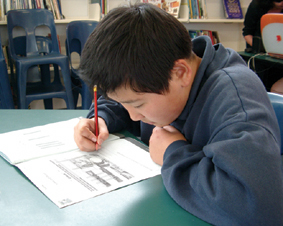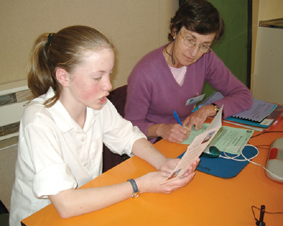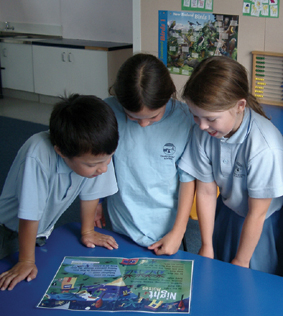Although national monitoring has been designed primarily to present an overall national picture of student achievement, there is some provision for reporting on performance differences among subgroups of the sample. Eight demographic variables are available for creating subgroups, with students divided into subgroups on each variable, as detailed in Chapter 1 (p5).
Analyses of the relative performance of subgroups used an overall score for each task, created by adding together scores for appropriate components of the task.
 Because
the number of students in-cluded in each analysis was quite large (approximately
450), the statistical tests were quite sensitive to small differences. To
reduce the likelihood of attention being drawn to unimportant differ-ences,
the critical level for statistical significance for tasks reporting results
for individual students was set at p = .01 (so that differences this large
or larger among the subgroups would not be expected by chance in more than
one percent of cases). For tasks administered to teams or groups of students,
p = .05 was used as the critical level, to compensate for the smaller numbers
of cases in the subgroups.
Because
the number of students in-cluded in each analysis was quite large (approximately
450), the statistical tests were quite sensitive to small differences. To
reduce the likelihood of attention being drawn to unimportant differ-ences,
the critical level for statistical significance for tasks reporting results
for individual students was set at p = .01 (so that differences this large
or larger among the subgroups would not be expected by chance in more than
one percent of cases). For tasks administered to teams or groups of students,
p = .05 was used as the critical level, to compensate for the smaller numbers
of cases in the subgroups.For the first three of the five school variables, statistically significant differences among the subgroups were found for less than 15 percent of the tasks at both year 4 and year 8. For the remaining two variables, statistically significant differences were found on higher proportions of tasks. In the detailed report below, all “differences” mentioned are statistically significant (to save space, the words “statistically significant” are omitted).
For year 4 students, there were differences among the subgroups on two of the 25 reading tasks, with students from large schools scoring highest and students from small schools scoring lowest on two oral reading tasks, Reading Record – Fiction (p17) and Reading Record – Non-Book (p20). There were no differences on any of the 20 speaking tasks, or on questions of the year 4 Reading and Speaking Survey (p61).
For year 8 students, there were differences among the subgroups on two of the 31 reading tasks, with students from large schools scoring high on Link Task 2 (p26) and Toyworld (p30). There were also differences on two of the 21 speaking tasks, with students from small schools scoring highest on Link Task 16 (p47) and Thank You (p56). There were no differences on questions of the year 8 Reading and Speaking Survey (p62).
For year 4 students, there were differences among the three subgroups on two of the 25 reading tasks, with students from Auckland scoring highest on What a Ride! (p35) and students from the South Island lowest on Körero Mai (p23). There were no differences on any of the 20 speaking tasks or on questions of the year 4 Reading and Speaking Survey (p61).
For year 8 students, there were differences among the three subgroups on four of the 31 reading tasks. Students from the South Island scored distinctly lowest on reading of Mäori text in Körero Mai (p23) and Link Task 1 (p26). Students from the South Island scored highest, and students from Auckland lowest on Wallabies in New Zealand (p28), and students from Auckland scored lowest on Link Task 7 (p41). There were no differences on any of the 21 speaking tasks or on questions of the year 8 Reading and Speaking Survey (p62).
For year 4 students, there were differences among the three subgroups on seven of the 25 reading tasks. Students from the main centres scored highest on Reading Record – Fiction (p17), Reading Record – Non-Book (p20), Nonsense You Might See and Hear (p24), and Link Task 5 (p41). Students from rural areas scored lowest on the first two of those tasks and also on Link Task 3 (p26), Toyworld (p30), and What a Ride! (p35). There were also differences on two of the 20 speaking tasks, with students from rural areas scoring highest on Hängi (p43), but lowest (with students from provincial cities highest) on Thank You (p56). There were no differences on questions of the year 4 Reading and Speaking Survey (p61).
For year 8 students, there was a difference among the three subgroups on one of the 31 reading tasks, with students from main centres scoring highest on Körero Mai (p23). There were also differences on four of the 21 speaking tasks. Students from provincial cities scored highest on Thank You (p56), while students from rural areas scored lowest on Explaining NEMP (p45), Link Task 17 (p57) and Link Task 18 (p57). There were no differences on questions of the year 8 Reading and Speaking Survey (p62).
 For
year 4 students, there were differences among the three subgroups on 22
of the 25 reading tasks and 18 of the 20 speaking tasks. Students from low
decile schools scored highest on one task involving reading Mäori text,
Link Task 1 (p26). On the remaining
21 reading tasks and the 18 speaking tasks, students from low decile schools
scored lower than students from high decile schools. Because of the large
number of tasks, they are not listed here. There were no differences on
questions of the year 4 Reading and Speaking
Survey (p61).
For
year 4 students, there were differences among the three subgroups on 22
of the 25 reading tasks and 18 of the 20 speaking tasks. Students from low
decile schools scored highest on one task involving reading Mäori text,
Link Task 1 (p26). On the remaining
21 reading tasks and the 18 speaking tasks, students from low decile schools
scored lower than students from high decile schools. Because of the large
number of tasks, they are not listed here. There were no differences on
questions of the year 4 Reading and Speaking
Survey (p61).For year 8 students, there were differences among the three subgroups on 27 of the 31 reading tasks and 18 of the 21 speaking tasks. Students from low decile schools scored highest on both tasks involving reading Mäori text. On the remaining 25 reading tasks and 18 speaking tasks, students from low decile schools scored lowest. While students from high SES schools generally did better than students from medium SES schools, these differences were usually smaller than the performance differences between students from low and medium SES schools. Because of the large number of tasks, they are not listed here. There were no differences on questions of the year 8 Reading and Speaking Survey (p62).
STUDENT VARIABLES
| • | Gender: boys and girls; |
| • | Ethnicity: Mäori, Pasifika and Pakeha (this term was used for all other students); |
| • | Language used predominantly at home: English and other. |
 During
the previous cycle of the Project (1999-2002), special supplementary samples
of students from schools with at least 15 percent Pasifika students enrolled
were included. These allowed the results of Pasifika students to be compared
with those of Mäori and Pakeha students attending these schools.
By 2002, with Pasifika enrolments having increased nationally, it was
decided that from 2003 onwards a better approach would be to compare the
results of Pasifika students in the main NEMP samples with the corresponding
results for Mäori and Pakeha students. This gives a nationally representative
picture, with the results more stable because the numbers of Mäori
and Pakeha students in the main samples are much larger than their numbers
previously in the special samples.
During
the previous cycle of the Project (1999-2002), special supplementary samples
of students from schools with at least 15 percent Pasifika students enrolled
were included. These allowed the results of Pasifika students to be compared
with those of Mäori and Pakeha students attending these schools.
By 2002, with Pasifika enrolments having increased nationally, it was
decided that from 2003 onwards a better approach would be to compare the
results of Pasifika students in the main NEMP samples with the corresponding
results for Mäori and Pakeha students. This gives a nationally representative
picture, with the results more stable because the numbers of Mäori
and Pakeha students in the main samples are much larger than their numbers
previously in the special samples.
The analyses reported compare the performances of boys and girls, Pakeha
and Mäori students, Pakeha and Pasifika students, and students from
predominantly English-speaking and non-English-speaking homes.
For each of these three comparisons, differences in task performance between
the two subgroups are described using “effect sizes” and statistical
significance.
For each
task and each year level, the analyses began with a t-test comparing the
performance of the two selected subgroups and checking for statistical
significance of the differences. Then the mean score obtained by students
in one subgroup was subtracted from the mean score obtained by students
in the other subgroup, and the difference in means was divided by the
pooled standard deviation of the scores obtained by the two groups of
students. This computed effect size describes the magnitude of the difference
between the two subgroups in a way that indicates the strength of the
difference and is not affected by the sample size. An effect size of +.30,
for instance, indicates that students in the first subgroup scored, on
average, three-tenths of a standard deviation higher than students in
the second subgroup.
For each pair of subgroups at each year level, the effect sizes of all
available tasks were averaged to produce a mean effect size for the curriculum
area and year level, giving an overall indication of the typical performance
difference between the two subgroups.
For year 4 students, the mean effect size across the 25 reading tasks was -.22 (girls averaged 0.22 standard deviations higher than boys). This is a moderate difference. There were statistically significant (p < .01) differences favouring girls on 12 of the 25 tasks: three involving oral reading and nine involving comprehension. The mean effect size across the 19 speaking tasks was -.15 (girls averaged 0.15 standard deviations higher than boys). This is a small difference. There were statistically significant differences favouring girls on two speaking tasks: Link Task 15 (p47) and Link Task 21 (p57). Girls also gave more positive ratings than boys on eight questions of the year 4 Reading and Speaking Survey (p61). They reported greater enjoyment of reading at school (question 1) and in their own time (question 8), and they were also more positive about receiving a book as a present (question 9), the stories or books in their school reading programme (question 12), how well they thought they read (question 14), reading out loud to the teacher (question 16), reading out loud to the class (question 17) and talking to the whole class (question 18).
For year 8 students, the mean effect size across the 31 reading tasks was -.15 (girls averaged 0.15 standard deviations higher than boys). This is a small difference. There were statistically significant (p < .01) differences favouring girls on seven of the 31 tasks: two involving oral reading and five involving comprehension. The mean effect size across the 20 speaking tasks was -.17 (girls averaged 0.17 standard deviations higher than boys). This is a small difference. There were statistically significant differences favouring girls on six speaking tasks, five of which were oral presentation tasks. Girls also were more positive than boys on one question of the year 8 Reading and Speaking Survey (p62): their enjoyment of the stories or books in their school reading programme (question 12).
 difference.
There were statistically significant (p < .01) differences on 18 of the
25 tasks, with Pakeha students higher on all of these tasks. The mean effect
size across the 19 speaking tasks was +.38 (Pakeha students averaged 0.38
standard deviations higher than Mäori students). This is a moderate
difference. Pakeha students scored statistically significantly higher on
11 of the 19 tasks. There was also a statistically significant difference
on one question of the year 4 Reading and
Speaking Survey (p61): Mäori students reported more guidance from
the teacher to help them improve their reading (question 6).
difference.
There were statistically significant (p < .01) differences on 18 of the
25 tasks, with Pakeha students higher on all of these tasks. The mean effect
size across the 19 speaking tasks was +.38 (Pakeha students averaged 0.38
standard deviations higher than Mäori students). This is a moderate
difference. Pakeha students scored statistically significantly higher on
11 of the 19 tasks. There was also a statistically significant difference
on one question of the year 4 Reading and
Speaking Survey (p61): Mäori students reported more guidance from
the teacher to help them improve their reading (question 6).For year 8 students, the mean effect size across the 31 reading tasks was +.30 (Pakeha students averaged 0.30 standard deviations higher than Mäori students). This is a moderate difference. There were statistically significant differences on 21 of the 31 tasks, with Pakeha students higher on 19 tasks involving reading in English and Mäori students higher on the two tasks involving reading in Mäori. The mean effect size across the 20 speaking tasks was +.34 (Pakeha students averaged 0.34 standard deviations higher than Mäori students). This is a moderate difference. Pakeha students scored statistically significantly higher on 11 of the 20 tasks. There were also statistically significant differences on three questions of the year 8 Reading and Speaking Survey (p62): Mäori students reported more guidance from the teacher to help them improve their reading (question 6), were less enthusiastic about reading in their own time (question 8), and were less enthusiastic about receiving a book as a present (question 10).
p = .05 has been used here as the critical level for statistical significance.
For year 4 students, the mean effect size across the 25 reading tasks was +.26 (Pakeha students averaged 0.26 standard deviations higher than Pasifika students). This is a moderate difference. There were statistically significant (p < .05) differences on nine of the 25 tasks, with Pakeha students higher on eight tasks involving reading for comprehension in English, and Pasifika students higher on one task involving reading in Mäori. The mean effect size across the 19 speaking tasks was +.52 (Pakeha students averaged 0.52 standard deviations higher than Pasifika students). This is a large difference. Pakeha students scored statistically significantly higher on 13 of the 19 tasks. There were also statistically significant differences on two questions of the year 4 Reading and Speaking Survey (p61): Pasifika students were more positive about reading at school (question 1) and reported fewer opportunities to talk to others in their class (question 21).
For year 8 students, the mean effect size across the 31 reading tasks was +.37 (Pakeha students averaged 0.37 standard deviations higher than Pasifika students). This is a moderate difference. There were statistically significant differences on 24 of the 31 tasks, with Pakeha students higher on 22 tasks involving reading in English and Pasifika students higher on both tasks involving reading in Mäori.
The mean effect size across the 20 speaking tasks was +.45 (Pakeha students averaged 0.45 standard deviations higher than Pasifika students). This is a large difference. Pakeha students scored statistically significantly higher on 12 of the 20 tasks. There were also statistically significant differences on two questions of the year 8 Reading and Speaking Survey (p62): Pasifika students reported more guidance from the teacher to help them improve their reading (question 6) and more opportunities to read to others at school (question 7).
For year 4 students, the mean effect size across the 25 reading tasks was +.23 (students for whom English was the predominant language at home averaged 0.23 standard deviations higher than the other students). This is a moderate difference. There were statistically significant differences on 14 of the 25 tasks: students for whom English was the predominant language spoken at home scored higher on 13 tasks but lower on one task involving reading Mäori text. The mean effect size across the 19 speaking tasks was +.28 (students for whom English was the predominant language at home averaged 0.28 standard deviations higher than the other students). This is a moderate difference. There were statistically significant differences, favouring those for whom English was the predominant language spoken at home, on eight tasks. There were also statistically significant differences on two questions of the year 4 Reading and Speaking Survey (p61): students for whom the predominant language at home was not English reported less positive parental views about their reading (question 4) but were more positive about reading out loud in class (question 17).
For year 8 students, the mean effect size across the 31 reading tasks was +.14 (students for whom English was the predominant language at home averaged 0.14 standard deviations higher than the other students). This is a small difference. There were statistically significant differences on 10 of the 31 tasks: students for whom English was the predominant language spoken at home scored higher on eight tasks but lower on both tasks involving reading Mäori text. The mean effect size across the 20 speaking tasks was +.21 (students for whom English was the predominant language at home averaged 0.21 standard deviations higher than the other students). This is a moderate difference. There were statistically significant differences, favouring those for whom English was the predominant language spoken at home, on five tasks (all oral description tasks). There were also statistically significant differences on seven questions of the year 8 Reading and Speaking Survey (p62): students for whom the predominant language at home was not English reported less positive parental views about their reading (question 4) and fewer opportunities to talk to others in class (question 21), but were more positive about reading in their own time (question 8), receiving a book as a present (question 10), looking at books in a bookshop (question 11), going to a library (question 12), and the stories or books in their reading programme at school.

For the comparisons of boys with girls, Pakeha with Mäori, Pakeha with Pasifika students, and students for whom the predominant language at home was English with those for whom it was not, effect sizes were used. Effect size is the difference in mean (average) performance of the two groups, divided by the pooled standard deviation of the scores on the particular task. For this summary, these effect sizes were averaged across tasks.
Girls averaged higher than boys on reading tasks, with a moderate mean effect size of 0.22 for year 4 students and a small mean effect size of 0.15 for year 8 students (the corresponding figures in 2000 were 0.25 and 0.10). The reading survey results showed that year 4 girls were markedly more enthusiastic about reading than year 4 boys, but there was little difference between year 8 girls and boys. On speaking tasks, the advantage of girls over boys was small, with mean effect sizes of 0.15 for year 4 students and 0.17 for year 8 students (the corresponding figures in 2000 were 0.24 and 0.06). These are small changes in disparity.
Pakeha students averaged higher than Mäori students on the tasks involving reading in English, with a large mean effect size of 0.42 for year 4 students and a moderate effect size of 0.37 for year 8 students (the corresponding figures in 2000 were 0.63 and 0.35). This indicates a substantial reduction in disparity for year 4 students, but no change for year 8 students. Mäori students averaged higher than Pakeha students on the two tasks involving reading in Mäori, with a small mean effect size of 0.19 for year 4 students and a large mean effect size of 0.76 for year 8 students (the corresponding figures in 2000 were 0.35 and 0.79). Pakeha students performed better than Mäori students on speaking tasks, with moderate mean effect sizes of 0.29 for year 4 students and 0.34 for year 8 students (the corresponding figures in 2000 were 0.41 for year 4 students and 0.35 for year 8 students). This indicates a slight reduction in disparity for year 4 students.
Pakeha students averaged higher than Pasifika students on the tasks involving reading in English, with a moderate mean effect size of 0.34 for year 4 students and a large mean effect size of 0.47 for year 8 students (the corresponding figures in 2000 were 0.64 and 0.60). This indicates a substantial reduction in disparity for year 4 students, with a small reduction for year 8 students. Pasifika students averaged higher than Pakeha students on the two tasks involving reading in Mäori, with large mean effect sizes of 0.66 for year 4 students and 1.09 for year 8 students (the corresponding figures in 2000 were 0.47 and 1.12). Pakeha students performed better than Pasifika students on speaking tasks, with large mean effect sizes of 0.52 for year 4 students and 0.45 for year 8 students (the corresponding figures in 2000 were 0.77 and 0.47, but these were based on a more restricted range of tasks).
Compared to students for whom the predominant language spoken at home was not English, students for whom the predominant language at home was English scored higher at both year levels on tasks involving reading and speaking in English. For reading in English, there was a moderate mean effect size of 0.29 for year 4 students and a small mean effect size of 0.18 for year 8 students. The corresponding figures for speaking tasks were 0.28 and 0.21, both moderate mean effect sizes. The students for whom the predominant language at home was not English scored higher at both year levels on the two tasks involving reading in Mäori, with a large mean effect size of 0.42 for year 4 students and a moderate mean effect size of 0.26 for year 8 students. No corresponding effect sizes from 2000 are available for any of these comparisons.